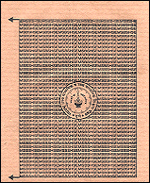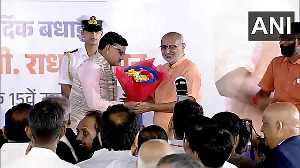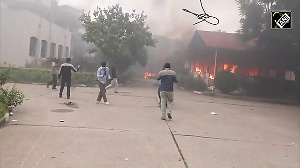The Maharashtra State Secondary and Higher Secondary Board is implementing the bar-coding system for tracking answer papers in the Senior Secondary Certificate and Higher Secondary Certificate examinations which begin on February 5.
 The idea is to remove defects in the current system that lead to malpractices or errors. Malpractices are encouraged by the ease with which a candidate's answer papers can be tracked in the current system, enabling unscrupulous students to contact and attempt to influence examiners or moderators. The errors occur most commonly in checking the papers and entering the marks.
The idea is to remove defects in the current system that lead to malpractices or errors. Malpractices are encouraged by the ease with which a candidate's answer papers can be tracked in the current system, enabling unscrupulous students to contact and attempt to influence examiners or moderators. The errors occur most commonly in checking the papers and entering the marks.
In the new system, at each examination, students will be supplied stickers with a bar code carrying information about their centre, seat number, and subject. Each student's sticker will be unique. The students will have to fill in their personal information on their answer booklets and paste the bar-coded sticker in the space provided. The personal information filled in by the students, along with the portion of the bar-coded sticker on which their seat number is printed, will then be concealed with an opaque khaki holographic sticker, leaving only the bar code visible.
Similar khaki stickers are to be pasted over the personal information box on supplementary answer sheets as well.
After the examination, all the answer booklets will be sent to the board's custodian.
Earlier, the centre conductor used to send the booklets directly to the designated examiner(s) and moderator(s) through the respective headmaster(s). This made it easy for unscrupulous students to find out who was evaluating their answer papers.
But now answer booklets from all centres will be sent to the custodian's office where they will be segregated into lots of 25 on the basis of subject and medium. These booklets will then be affixed with a UID [universal identification number] sticker. These bar-coded stickers will carry information about the subject, section, medium of answer, lot number, and serial number of the answer booklets in that lot.
The lots will then be sent to the designated examiners and moderators. A list will be maintained as to which UID lot has been sent to which examiner/moderator.
 Thus, when an examiner or moderator receives the answer booklets, s/he will be unable to find out where they originated. The only way of finding that out at any stage is to pull off the khaki sticker covering the personal information, but that will clearly indicate an attempt to tamper with the process.
Thus, when an examiner or moderator receives the answer booklets, s/he will be unable to find out where they originated. The only way of finding that out at any stage is to pull off the khaki sticker covering the personal information, but that will clearly indicate an attempt to tamper with the process.
After checking the answer papers, the examiner will enter the marks, question-wise, on the front page of the answer booklet and send the lots back to the custodian, who will tally the lots with the list of examiners/moderators.
The booklets will then be scanned to read the candidate's number from the first bar code and the marks attained by the student will be tallied by the computer, thus eliminating any chance of a mistake in the tallying or the marks of Student A being credited to Student B.
The board had implemented the system on an experimental basis in October 2002 for the English paper of the SSC examination and all subjects of the HSC examination. Pleased with the results, it decided to implement the system for all papers in all its eight divisions in the state from this year on. The system applies only to the theory papers and not the practical tests, however.
"The state is incurring no expense on this system," the board's Mumbai divisional secretary, Suryakant Patil, said. "The entire cost is being recovered from the students, who are being charged an additional Rs 20 on their examination fee, which goes towards this bar-coding exercise." Patil said 183,948 students are expected to appear for the HSC examination this year and 290,369 for the SSC examination.
He said the bar-coding system is already in use in neighbouring Gujarat. "But we have adapted it to our system with a few modifications relating to evaluation procedures," he said. "We have a huge population of students and therefore the evaluation work has to be properly allocated."
Patil said the SSC and HSC examinations are crucial for students and so the need for a foolproof system was felt strongly.
The board has directed all schools and colleges to explain the procedure to their students. Students have also been directed to report half an hour early at their examination centres, so that the procedure can be explained to them.
Jaihind College at Churchgate in south Mumbai held a one-hour workshop on Saturday to explain the new system to students. All HSC students had to attend the session compulsorily, where they were taken step by step through the procedure and the dos and don'ts.
Samrat Lal, a student in the college, was not very enthusiastic. "I think they should be giving us more time at the end for sticking the holographs on our additional sheets," he complained. "But the security part is good. So in that way, it's a step in the right direction."
Nisha Sikka, who teaches Hindi in the college, said she fully agreed with the need for the new system. "There should not be any malpractice," she said. "The students are grumbling because they are really tense about the examination and over and above that they have to deal with these new procedures. But they should not find it difficult. I guess they will get used to this system."
Sonal Sethna, supervisor of Jaihind Junior College, said they decided to conduct the workshop to give students a feel for this system and increase their confidence. "It [the system] should work," she said. "It looks as if it should work. But I don't know if people find out loopholes in this system also."





